What's inside
While other muscle groups are important, the chest and shoulders take priority in many training programs – and for good reason.
The chest is the centerpiece of the body and portrays a sense of size and power.
The shoulders create a wide, athletic appearance, especially when coupled with a narrow waist.
This article contains a breakdown of why and how the chest and shoulders can be trained in the same session.
It contains a list of the absolute best chest and shoulder exercises for maximal muscle activation, strength building, and growth.
There are also chest and shoulder workout plans for beginner and advanced levels. You can choose a shoulder and chest workout with dumbbells to do at home, or a plan for the gym.
Can I do a shoulder and chest workout together?
Related: 67 Gym Slang Terms
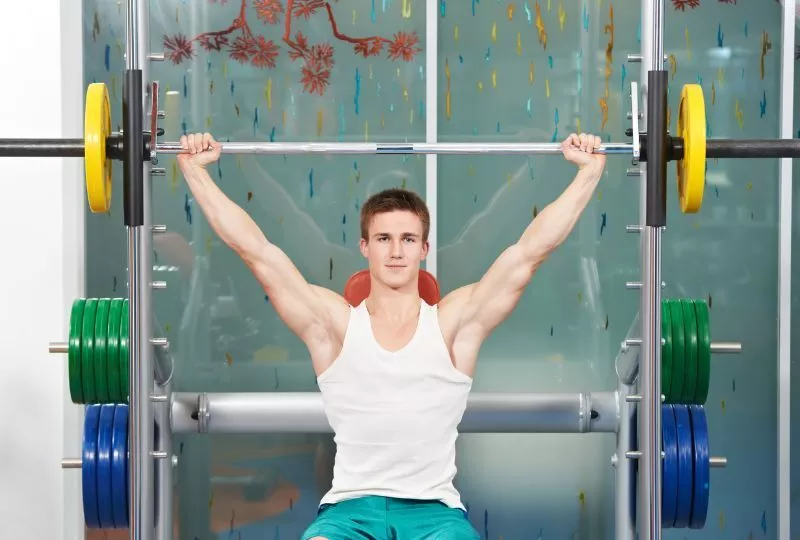
The chest and shoulder muscles are what are known as synergists. This means they work together to perform the same movement patterns.
Many workout programs include workouts that train chest and at least the anterior and middle deltoid together.
This is often done together with the triceps, as they are also synergistic muscles in upper-body pushing movements.
While the chest and shoulders can be isolated, most pushing movements use them in conjunction.
The following section will show how the structure of the chest and shoulder muscles makes them perfect workout partners.
Chest and Shoulder Anatomy
Related: Bad Chest Genetics
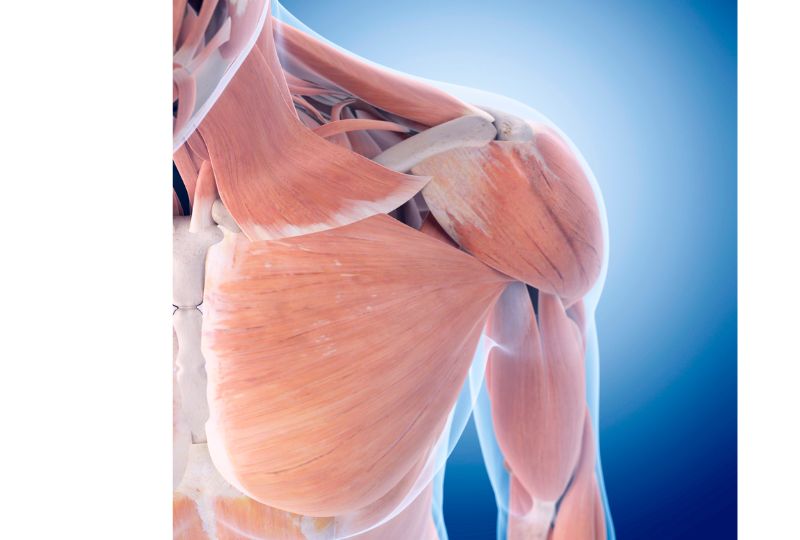
What we call the chest muscle is the pectoralis major. However, this one muscle has several distinct sections with muscle fibers running in different directions.
The pecs run from the mid-chest to attach to the upper humerus (upper arm bone).
The upper portion is called the clavicular head (pars clavicularis), originating from the collarbone.
The middle section is the sternal head (pars sternocostalis) running from the sternum or breastplate.
The lower fibers of the pec (pars abdominalis) flow in an upward direction from the ribs into the common tendon.
The major movements of the pectoralis muscle include shoulder flexion, horizontal flexion, and adduction.
The superficial muscle of the shoulder is called the deltoid, and it also has three distinct sections.
The anterior head is active in shoulder flexion, the middle head in abduction, and the posterior section in shoulder extension and horizontal extension.
There are also important deep muscles of the shoulder joint called the rotator cuff.
These four muscles are critical in internal and external rotation of the shoulder, as well as in securing the arm into the shoulder socket.
While each of these muscles – and even portions of them – have varying roles, they are definitely used in combination for compound, functional movements.
The Best Chest and Shoulder Workout Exercises
Related: Top 10 Exercises & A Full Dumbbell Chest Workout Without Bench
With a bit of background information about the muscles, their features, and movements, let’s take a look at the best exercises for each.
These exercises are chosen based on their ability to maximally activate a muscle, either as an overall unit or for a distinct portion.
6 Best Chest Exercises
Related: The 6 Day Gym Workout Schedule With PDF
1. Barbell Bench Press
The king of chest exercises, the barbell bench press creates the highest overall activation in the pecs.
This is because the exercise allows you to lift the most weight with a good balance between machine and dumbbell work.
This should be the foundation of your chest-building program if you have access to the equipment.
Equipment Requirements: Bench, barbell, plates, rack, clips
How-To Perform Barbell Bench Press:
- Lie on flat bench
- Lift bar from rack
- Breathe in and lower bar to just above mid-chest
- Breathe out and use the chest to push bar until arms straight
- Perform desired repetitions
- Return bar to rack
Benefits: Highest pec muscle activation, able to lift the most weight
Pro Tips: Plant the heels, squeeze the glutes, and arch the back slightly for a strong base position.
2. Incline Bench Press
This variation of the barbell bench is the next step in total chest development.
The incline angle targets the upper or clavicular head of the chest more, developing that shelf-like upper chest that stands out in a side pose.
While not being able to lift as much weight as the flat bench, you’ll get a great stretch and range of motion with this move.
Equipment Requirements: Adjustable bench, barbell, plates, rack, clips
How-To Perform Incline Bench Press:
- Lie on incline bench
- Unrack bar with arms locked
- Inhale and lower bar to upper chest
- Exhale as you push to starting position
- Repeat for reps
- Rack the weight
Benefits: Targets upper fibers of the chest, ties pecs and shoulders together
Pro Tips: Bring the bar right to the upper chest and squeeze shoulders back at the bottom for a good stretch to the upper fibers.
3. Cable Crossover
Related: Inner Chest Workout Program
A killer chest isolation exercise, the crossover is a very close second to the bench press in terms of pec activation.
This exercise allows you to adduct the arms across the midline of the body, getting an epic contraction of the inner chest.
Another advantage here is that you can adjust the height of the cables, to target the lower, mid, or upper portion of the chest, depending on your goals.
Equipment Requirements: Cable machine, single handles
How-To Perform Cable Crossover:
- Set pulleys to desired position
- Set weights to desired resistance – same on both sides
- Hold one pulley in each hand
- Step one foot forward with hands together in front
- Lean slightly forward at the hips
- Breathe in and extend arms out to the sides in an arc motion
- Keep elbows slightly bent
- Breathe out and squeeze chest as you bring hands back together
- Perform desired repetitions
- Carefully lower one handle at a time to release the weight
Benefits: Very high pec activation, adjustable to target different portions of the chest
Pro Tips: Cross one hand over the other for extra resisted shoulder adduction to really contract the inner chest.
4. Dumbbell Bench Press
Our first home option for chest, the dumbbell bench press adds an element of coordination to the traditional barbell version.
While this leads to slightly less (around 17% less than barbell) muscle activation in the pecs, the overall muscle activity in stabilizers like the biceps is higher.
If you can get a good set of dumbbells, this move is the foundation of your home chest workout.
Equipment Requirements: Bench, dumbbells
How-To Perform Dumbbell Bench Press:
- Lie on flat bench with dumbbells at shoulder width, palms facing away
- Make a 90-degree angle at elbows with weights on either side of chest
- Breathe out and use chest to push dumbbells up
- Squeeze chest at top of movement
- Slowly lower dumbbells to starting position
- Repeat for reps
- Bring weights to chest and use legs to sit up
Benefits: Versatile, more stabilization with free weights
Pro Tips: Bring the ends of the dumbbell together at the top and squeeze for extra range of motion.
5. Dumbbell Incline Press
In the same vein as the incline barbell press, the dumbbell variation also has its own unique benefits.
Having each hand free allows you to develop each side of the chest evenly without the dominant side taking over.
Without the bar across the chest, you can also get a deeper press at the bottom, providing a good stretch to the pec muscle.
Equipment Requirements: Adjustable bench, dumbbells
How-To Perform Dumbbell Incline Press:
- Lie on incline bench with dumbbell on each thigh
- Use legs to help lift dumbbells to starting position on either side of chest
- Extend arms and bring dumbbells together at the top
- Inhale and slowly lower weights until elbows back at 90 degrees
- Perform desired number of reps
- Bring weights back to thighs as you sit forward
Benefits: Able to rotate hands through movement, more stretch on upper fibers
Pro Tips: Rotate the hands to a neutral position at the bottom for a deeper press.
6. Chest Dips
Finally, we have the king of bodyweight chest developers – and it’s not the humble push-up as you might think.
The parallel dip is an excellent stimulus for the lower chest and provides as much range of motion as you could want.
Progress this exercise with added weight for a great home chest exercise that will develop your strength and body control.
For more information on bodyweight exercises, check out our complete guide to calisthenics training.
Equipment Requirements: Parallel bars
How-To Perform Chest Dips:
- Hold body above bars with arms locked out
- Lean forward slightly
- Inhale and lower down until you feel stretch in chest
- Use pecs to push up to starting position
- Squeeze chest at the top of the movement
Benefits: Challenging bodyweight move, hits lower chest
Pro Tips: Avoid lowering too far, to keep the shoulder joint from strain or injury.
6 Best Shoulder Exercises
Related: Resistance Band Shoulder Exercises
1. Military Press
If the bench press is the ultimate chest exercise, its delt-building equivalent is undoubtedly the military press.
Also known as the shoulder press or overhead press, this barbell compound move is the ultimate strength builder for the front and middle delts.
This exercise also recruits the entire body, especially the glutes and core, as a strong and stable base for the press.
Building strength in this exercise will increase your upper body ability in every other movement.
Equipment Requirements: Barbell, plates, clips
How-To Perform Military Press:
- Stand with barbell in front
- Grab the bar shoulder width or slightly wider
- Clean the bar to the upper chest
- Exhale and press the bar overhead, moving head out of the way
- Breathe in and slowly lower bar back to shoulders
- Perform reps and control bar back to floor
Benefits: High anterior and middle delt activation, functional movement
Pro Tips: The legs, glutes, and core are the base of this exercise, so keep them engaged at all times.
2. Cable Lateral Raise
While compound movements such as presses allow you to lift a lot of weight by using the delts as synergists, this exercise is a must-include for isolation.
The lateral raise is the exercise for building the wide, ‘capped’ shoulder look so sought-after by bodybuilders.
The added advantage of the cable variation is that it has an even strength curve, as the resistance is even throughout the range of motion.
Equipment Requirements: Cable machine, single handles
How-To Perform Cable Lateral Raise:
- Stand side-on to a low cable handle
- Pick up the handle and hold the support with other hand
- Lean out slightly, angled away from the rack
- Contract the delt to lift the arm out to the side
- Keep the elbow unlocked, and slowly control the handle back down
- Repeat for reps and carefully lower the weight onto the stack
Benefits: Best ‘capped’ delt builder, consistent resistance through range of motion
Pro Tips: Think of reaching the hand outward to avoid the traps aiding the movement.
3. Reverse Fly Machine
For a complete, round delt muscle, it’s critical to include an exercise in your workout for the rear shoulders.
This portion of the muscle makes a massive difference in the look of the shoulders, especially from the side.
The reverse fly machine creates the most stimulus for the posterior deltoid, giving it the work it needs to grow.
While this exercise can also be part of a back workout, for completeness we’ve included it in the chest and shoulder program.
Equipment Requirements: Fly/butterfly machine
How-To Perform Reverse Fly Machine:
- Set the machine handles fully to the rear
- Sit with the chest against the backrest with hands at shoulder height
- Press chest into the pad while squeezing rear delts to pull arms out and back
- Contract and focus on rear shoulders, holding for a second
- Slowly control handles back together without relaxing fully
- Repeat repetitions, breathing out for contraction and in to return weight
Benefits: High rear delt activation, completes 3D delt look
Pro Tips: Try to keep the shoulder blades protracted to let the rear delts take the load.
4. Arnold Press
Named after the biggest legend in bodybuilding, Arnold Schwarzenegger, the Arnold press is the home equivalent for those who can’t do the barbell press.
The unique movement pattern in the Arnold press creates more range and tension for the anterior deltoid.
In true Arnold style, this exercise also creates a terrific pump in the delts, leaving them looking and feeling large and round after the workout.
Equipment Requirements: Adjustable bench, dumbbells
How-To Perform Arnold Press:
- Sit on bench with back support
- Hold dumbbells in front of shoulders, palms facing you
- Breathe out and press dumbbells overhead, rotating hands to front at the top
- Slowly control the weight down in a reverse pattern to starting position
Benefits: Good stretch through range of movement, great shoulder pump
Pro Tips: Sit with good posture, chest proud and chin up.
5. Dumbbell Lateral Raise
This variation of the lateral raise is perfect for the home workout to again create wide, aesthetic shoulders.
This exercise has higher activation for the middle delts than the overhead press, so it’s important to include it xto fully develop the shoulder.
Technique and the mind-muscle connection are key for this exercise, as it is a common culprit of ‘cheating’ the movement.
Master this exercise and you’ll be walking sideways through doorways in no time.
Equipment Requirements: Dumbbells
How-To Perform Dumbbell Lateral Raise:
- Stand with dumbbells hanging at either side
- Stand tall and focus on middle delts while lifting weights up and out
- Finish with the arms at shoulder level, slightly in front of the body
- Keep the elbows unlocked while slowly lowering to the starting position
Benefits: Go-to home delt builder, good for a quick pump
Pro Tips: Avoid swinging the weights – control is key in this movement to build the delts.
6. Shoulder External Rotation
While the exercises above are all you need to build huge, developed chest and shoulder muscles, a shoulder injury can put a quick halt to your progress.
External rotations of the shoulder joint using the rotator cuff muscles is key to bullet-proofing the shoulder to keep it in fighting shape.
Either the cable or dumbbell variations can be used to keep your shoulder healthy and strong, depending on what equipment you have available.
Equipment Requirements: Cable machine, single handle, dumbbell
How-To Perform Dumbbell Shoulder External Rotation:
- Lay on one side with the bottom hand supporting the head
- Rest the upper arm on the side body, holding a dumbbell across the stomach
- Keep the upper arm and elbow in place while rotating the dumbbell upwards
- Slowly control the weight back down without relaxing completely
- Repeat on opposite side
How-To Perform Cable Shoulder External Rotation:
Related: Cable Shoulder Workouts
- Stand side-on to a cable handle at the level of the upper abdomen
- Hold the handle with the forearm across the stomach
- Stand tall and focus deep in the rear shoulder to rotate the handle outwards
- Keep the elbow and upper arm locked to the side as you slowly return the handle to the start
Benefits: Strengthens rotator cuff muscles, protects entire shoulder from injury
Pro Tips: Don’t skip this exercise! It is the key to long-term shoulder strength and health.
The Best Chest and Shoulder Workout Program
Related: Rear Delt Exercises
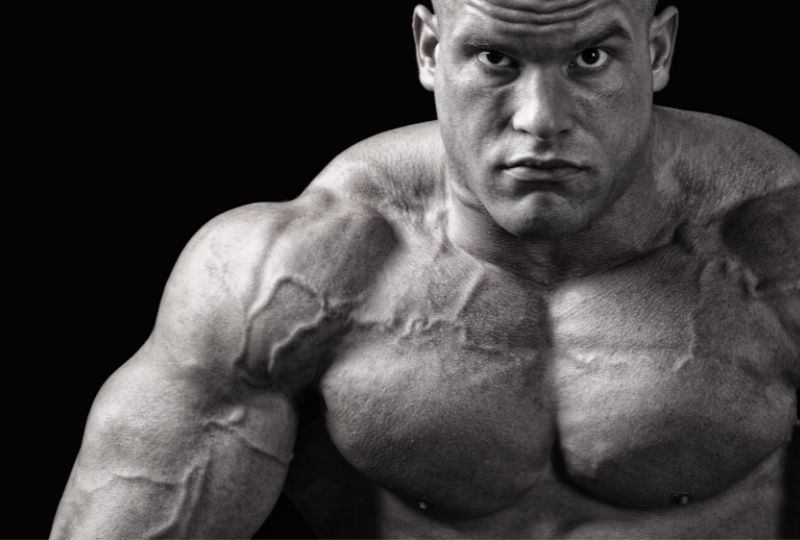
Now that we have the best exercises to build the chest and shoulders, it’s time to get into the workouts you can use to start making progress.
Since these workouts focus on the pecs and delts, they are best split with workouts for the back, arms, legs, and core.
The following workouts include options for beginners and more advanced lifters.
There are workouts that can take advantage of a full gym, plus options for a shoulder and chest workout at home with just a pair of dumbbells.
Chest & Shoulders Workout with Dumbbells at Home
Beginner
Related: 7 Day Gym Workout Plan For Beginners
| Exercise | Sets x Reps | Rest |
| Dumbbell bench press | 3×10-12 | 60-90 sec |
| Arnold press | 3×10-12 | 60-90 sec |
| Dumbbell lateral raise | 3×10-12 | 1 min |
| Push-ups | 3xMAX | 1 min |
| Dumbbell shoulder external rotation | 3×10-15 | 30 sec |
Advanced
| Exercise | Sets x Reps | Rest |
| Dumbbell bench press | 3×8-12 | 60-90 sec |
| Dumbbell incline press | 3×8-12 | 60-90 sec |
| Arnold press | 3×8-12 | 60-90 sec |
| Dumbbell lateral raise | 4×15-20 | 1 min |
| Chest dips | 3xMAX | 1 min |
| Dumbbell shoulder external rotation | 3×10-15 | 30 sec |
Chest and Shoulder Gym Workout
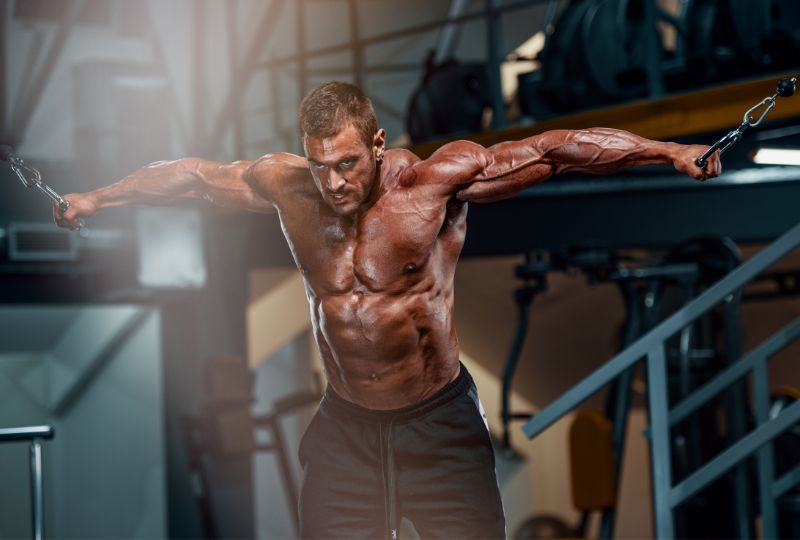
Beginner
| Exercise | Sets x Reps | Rest |
| Barbell bench press | 3×10-12 | 60-90 sec |
| Military press | 3×12-15 | 60-90 sec |
| Cable crossover | 3×10-12 | 1 min |
| Cable lateral raise | 3×12-15 | 1 min |
| Cable shoulder external rotation | 3×10-15 | 30 sec |
Advanced
| Exercise | Sets x Reps | Rest |
| Barbell bench press | 3×8-12 | 60-90 sec |
| Barbell incline press | 3×8-12 | 60-90 sec |
| Cable crossover | 3×8-12 | 60-90 sec |
| Cable lateral raise | 4×15-20 | 1 min |
| Reverse fly machine | 4×8-12 | 1 min |
| Cable shoulder external rotation | 3×10-15 | 30 sec |
Pro Tips for Effective Chest and Shoulder Training
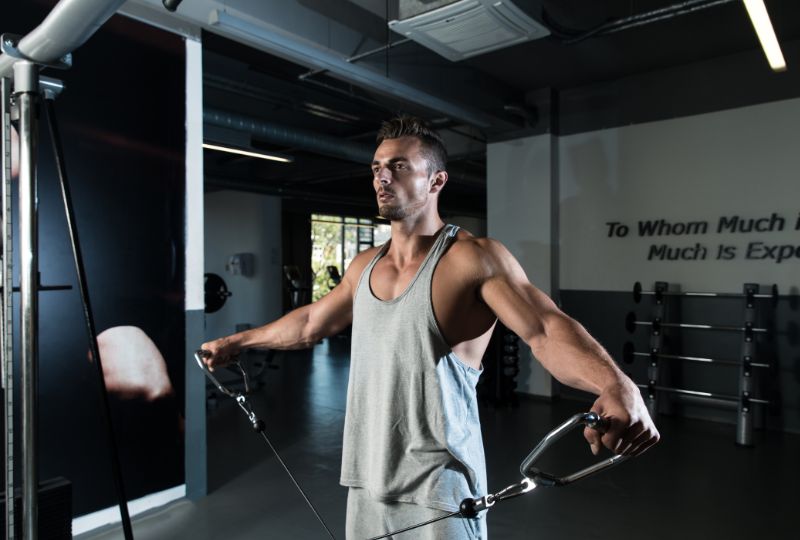
Types of Tension
The muscles of the chest and shoulders respond well to both heavy loads and higher repetitions.
Include and alternate between heavy work and metabolic stress to keep stimulating the muscles to grow.
Mind-Muscle Connection
While knowing what the movement looks like is one thing, the real key is where you feel an exercise working.
For the exercises above, focus on the muscle you are trying to work. Make sure you adjust the movement until you really feel the target muscle working.
Train Hard
The chest and shoulders often take priority in many programs, but sometimes people get stale or lazy in their sessions.
To ensure these muscles keep growing and getting stronger, it’s important to push hard, especially in those last couple of sets.
Rotate
While the programs in this article are a great starting point, they are by no means set in stone.
If you find yourself hitting a plateau or not progressing as you’d like, try rotating the exercises around to prioritize the muscles differently.
Likewise, if you have any lagging muscles – like the rear delts or upper chest – make sure to perform these exercises first, while you’re fresh.
Technique
In addition to the rotator cuff strengthening work mentioned above, technique is critical in avoiding injury to the shoulder joint.
Start with light weight and really master the technique and mind-muscle connection before going too heavy.
Recovery
The workouts in this guide are best done once or twice per week, with at least two days between sessions.
Also make sure your nutrition, sleep, and other recovery methods are up to scratch to keep the gains coming.
Partner Up
With heavy compound lifts like the bench press and military press – and even with isolation moves – a workout partner can be key in helping you push harder.
Having a spotter can give you the confidence to try that next PR in your bench or to help you push past failure when you want to quit.
Progress
Like any workout plan, make sure you track your workouts and always try to be progressing.
Whether it’s an extra rep, increasing the weight, or adding a set to a certain exercise, your gains will only continue as long as you provide a reason to.
Frequently Asked Questions
Related: Bodyweight Workout Plan PDF
Should you do shoulders and chest on the same day?
The muscles of the chest and shoulders make perfect workout buddies as they complement each other in many pushing movements.
Since the shoulders already work in many chest exercises – and vice versa – it makes sense to train these muscles together.
Some advanced programs can isolate the chest and shoulders from each other, but in most cases, they go well together in a workout.
What is the best exercise for chest and shoulders?
Several exercises could make a case for ‘best’ exercise, but it depends on the goal.
The exercises in this article cover the best moves for overall muscle activation, as well as for isolating and recruiting each section of the pecs and deltoids.
What is the best chest and shoulder workout routine?
The workouts in this guide are good examples of some killer chest and shoulder workouts for different situations.
Whether you’re a newbie just training at home, or a more experienced lifter looking to sculpt your chest and shoulders, there’s an option here for you.
Closing Comments
So, what do you think about our chest and shoulder training tips?
Let us know your favorite chest and shoulder exercises – and if you train them together – in the comments.
If you know someone who could use some tips to grow their chest and shoulders, be sure to send them this article as a starting point.

